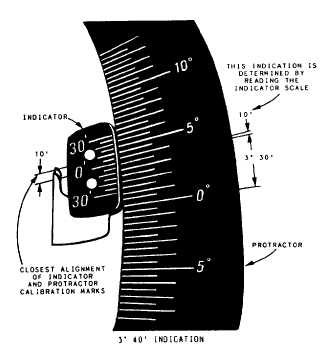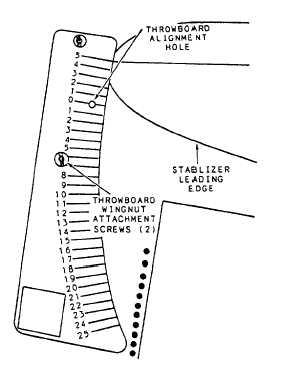Read the value from the 0-minute mark on the
indicator to the closest alignment, which, in this
example, is 10 minutes.
3. Add 3 degrees 30 minutes and 10 minutes to
get the true indication of 3 degrees 40 minutes up
travel.
Each mode of operation that was affected by
alignment or malfunction and subsequent repair
action must be operationally checked, and the success
of the checkouts verified by a qualified quality
assurance representative. All maintenance, including
alignment, adjustment, operational testing, and
component replacement, must be in accordance with
the instructions provided in the applicable MIM.
CABLE AND RIGID CONTROL
SYSTEMS MAINTENANCE
Cable and rigid control systems maintenance
includes inspection to discover actual and potential
defects, servicing with lubricants, and correction of
reported malfunctions and defects. Malfunctions that
occur in control systems include frayed and loosened
bearings, unnatural tightness (binding), and broken or
damaged components.
Figure 9-18.—Stabilizer throwboard installation.
Cable Control Systems
Cables have many advantages. They will not
sever readily under sudden strains. Cables are
stronger than steel rods or tubing of the same size.
They flex without setting (permanent deformation)
and can be led easily around obstacles by using
pulleys. Cables can be installed over long distances
(such as in large aircraft) without a great degree of
sagging or bending. Vibration will not cause them to
harden, crystallize, or break, as may be the case with
push-pull control rods. Because of the great number
of wires used in cables, cable failure is never abrupt,
but is progressive over periods of extended use.
When used for the manipulation of a unit in a control
system, they are usually worked in pairs-one cable
to move the unit in one direction, the other to move it
in the opposite direction. Weight is saved in spite of a
second cable because the push-pull rod needed to
cause a similar movement in a unit would have to be
quite thick and heavy (comparatively speaking).
Since cables are used in pairs and are stretched taut,
very little play is present in system controls, and no
lost motion exists between the actuating device and
the unit. Consequently, cable-controlled units
respond quickly and accurately to cockpit control
movement. In some simple cable systems, only one
cable is used, and a spring provides the return action.
Figure 9-19.—Aileron throw protractor indications.
9-25



